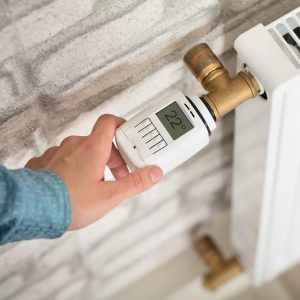Money Saving Advice: High Energy Prices in the UK
Another season, come and gone. As the last autumn leaves crunch and crumble underneath ...
Plumbing on Tap does not cut any corners on a power flush! A full day is spent flushing the system and using the best chemicals. We clean through the central heating system pipework and all central heating radiators at the property. Our Brighton plumbing specialists advise one radiator must be taken off the wall in order for the power flush to take place.
Power flush machine set up so water flows through the radiators and heating pipework collecting all the iron oxide sludge, before reaching the boiler to minimize debris entering boiler heat exchanger.
Rust remover chemical (normally phosphoric acid based, an ingredient in Cola drinks and why a rusty coin is cleaned by Cola) is added and boiler turned on.
By concentrating flow through individual radiators and vibrating the radiators the rust spots are removed. One by one radiators, heating coils and all pipe work are power flushed with clean water until water samples show clean and neutral readings. Small amount of Neutraliser is added to compensate for residual chemical cleaner, then Rust Inhibitor is added and circulated throughout the system.



A power flush can be installed quickly and at your convenience. After getting one, you’ll notice that your heating system is quieter, more efficient and heats up quickly. This is because there is unhindered circulation in the system, as the radiators provide consistent heat from bottom to top. Furthermore, the increased efficiency of your boilers can help save you up to 25% on your energy bills. This is more so, because running a routine power flush helps to detect any minor faults in your system and takes care of them before they develop into a larger problem over time.
You might already be aware that a power flush for your central heating system provides many benefits, including up to 25% reduction in your energy bills. You could also notice the following benefits after a power flush:
When you notice any of the symptoms below, it means there could be corrosion or sludge in your system and a power flush would subsequently be required:
A qualified engineer can help you decide if and when you need a power flush, as well as alert you to any potential risks in your system. The materials used on your heat exchanger have much to contribute, with regards the likelihood of debris and sludge formation in the system.
It’s not uncommon for rust and other debris to deposit and form sludge in the boiler, radiators, and pipe work, as your central heating system ages over time. A power flush is a cleansing process which aims to remove these deposits. These contaminants seriously affect the efficiency of a heating system if left unchecked by causing blockages and corrosion, ultimately leading to a potential breakdown.
High strength cleansing chemicals – including a sludge breaker, corrosion inhibitor, and descaler – are rapidly circulated throughout the system during a power flush to clear away debris, limescale and sludge. This process is ideal in maintaining your central heating system and helps to boost the amount of heat that’s permitted from your radiators.

Emergency Plumbing call out at short notice. Problem sorted quickly and efficiently. Excellent service.
Turned up on time, courteous, friendly, finished the job efficiently (boiler service), charged what I was quoted. Recommended.
Fantastic service from start to finish. Will defiantly recommend this company and use them again.
Quick response time which was great as water was pouring out from under my sink, very quick to fix the problem, tidy and courteous engineer, would highly recommend for anyone in need of a plumber, Top job.
Excellent customer service and knowledgeable tradesman. Work carried out with minimum fuss and felt comfortable from the word go.
Have used plumbing on tap for a new boiler and annual check ups. Very helpful and thorough would use them again and recommend to others.
Plumbing on tap have always been super efficient, I have never had to ask for something to be redone, and once they have the job I don't need to chase them which is handy considering I run a busy letting agency..
Fixed my kitchen tap, fixed a leak in my bath, dispatched a handyman to re-grout my bath. Excellent work. Very satisfied!!
Such a lifesaver!! They came out to us right away, and were very friendly and helpful and explained what was wrong with our boiler. Will definitely be using them in future again! Thank you so much!
Great company and highly recommended. Flexible to suit my busy schedule and came when I needed them too. Did a great job at a reasonable price; quick and efficient in the process and no hidden extras at the end. Would definitely use again.
A responsive time, good job at a fair price. That was all I asked for and that was what I got. So I am happy to recommend Plumbing On Tap, even if they did end up sharing the Hove Business Award for Best Professional Service, with me! Thanks aga...
Super great service today! Gavin installed my curtains and did a brilliant job, super friendly and lovely guy will defiantly use Ontap and highly recommend!
Excellent service, lovely people.
Another season, come and gone. As the last autumn leaves crunch and crumble underneath ...
Our very own Elliott Raggio will be playing in a charity football match next ...
Gas Safety Week coming 10th September -16th September. Don’t be fooled by cowboy fitters ...
Today we were presented with a certificate from the offices of Checkatrade for collecting ...